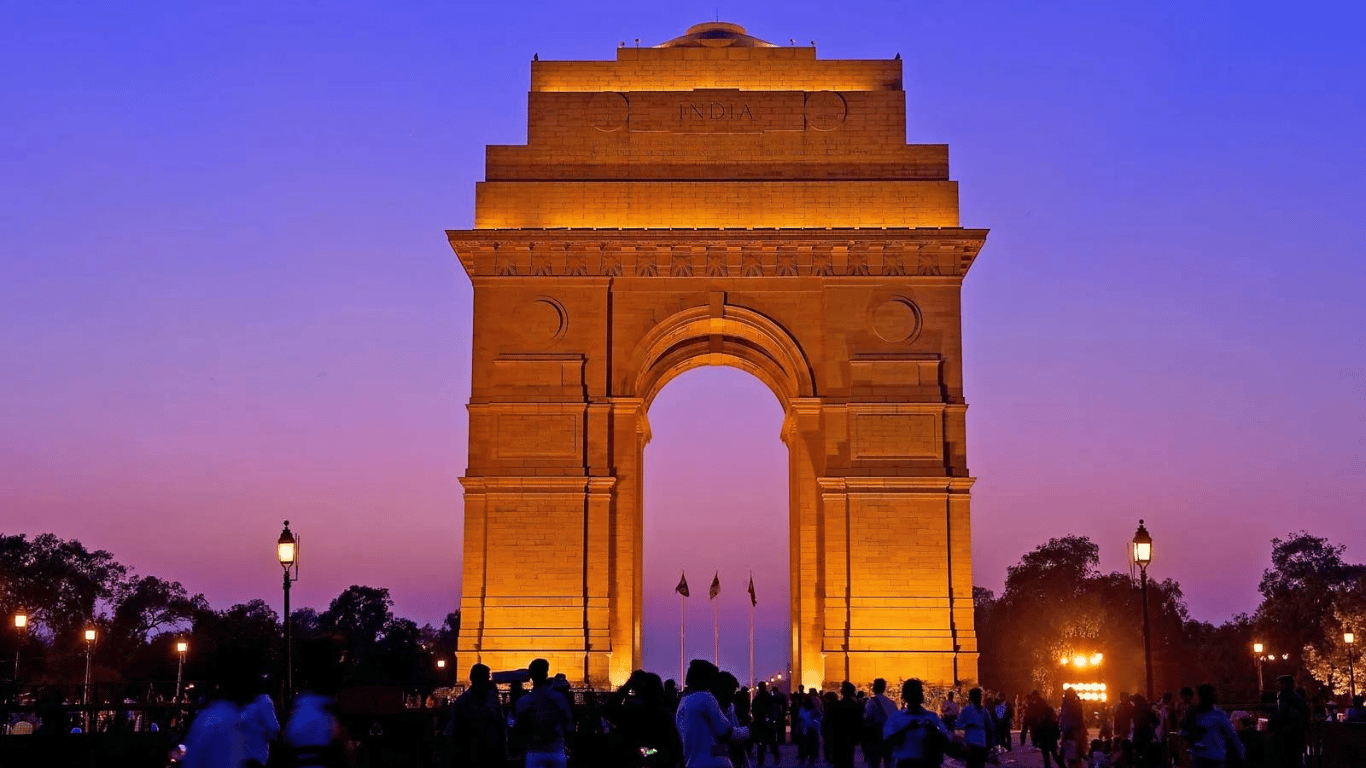
Amid a week filled with the grind of daily life, the prospect of a weekend brings a wide smile to people’s faces. Even if an individual thrives on the daily hustle, a change is welcome after a few days. This feeling holds true in Delhi where life is consistently busy. So, the weekend becomes a much-anticipated escape. Fortunately, there are numerous enticing places to visit near Delhi, ensuring diverse and thrilling experiences.
1. Agra- 233 Km
Agra stands as a prominent tourist destination in North India, renowned for its exquisite Mughal-era structures like the Taj Mahal, Agra Fort, and Fatehpur Sikri, all UNESCO World Heritage Sites. The city boasts a distinctive ambiance that transports visitors back to the Mughal era, showcasing remarkable architecture and historic sites. Topping the list of attractions is the iconic Taj Mahal, a testament to exquisite Mughal craftsmanship and one of the Seven Wonders of the World. Commissioned by Shah Jahan in memory of his beloved wife, Arjumand Bano Begum, the Taj Mahal’s design seamlessly blends Persian and Mughal architectural influences.
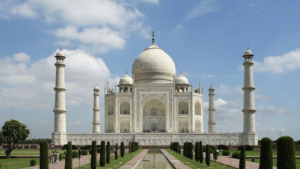
Agra Fort is located near the Taj Mahal gardens. Within its confines, you’ll discover splendid palaces like Jahangir Palace and Khas Palace, along with notable structures such as the Diwan-i-Khas, a grand hall of audiences. The fort also houses magnificent mosques, adding to its architectural grandeur. Best time to visit is between August to March.
2. Nainital- 358 Km
Nainital, a charming hill resort town, draws its essence from the serene, eye-shaped lake around which the town flourishes. Established in 1841, Nainital stands as a sanctuary from the urban hustle and bustle, a testament to the insightful founding. As you enter the district, a parallel world unfolds, captivating the senses with its scenic splendour. The transition into this haven becomes a soothing experience, a blissful retreat that can only be fully appreciated through first-hand encounters.
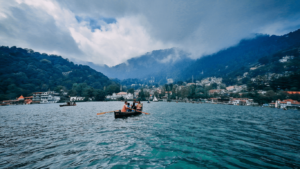
Nainital, with its dreamlike allure, served as a retreat for the British elites seeking respite from the harsh Indian mainland summers and it indeed has something special for everyone. From the sacred Naina Devi temple and St John in Wilderness to the Hanuman Garhi and Raj Bhawan- Nainital got it all. Nature enthusiasts and adventure lovers can revel in the wonders of Naini Lake, Nainital Zoo, Jim Corbett National Park, Eco cave gardens, Tiffin Top and Snow Viewpoint. November- May is the best time to visit.
3. Mussoorie- 289 Km
Mussoorie, immortalized in the narratives of the great author Ruskin Bond, has evolved into a realm of nature’s romanticism, adorned with landmarks woven into his timeless novels and short stories. Its history dates back to the 19th century when officers of the East India Company developed it into a holiday haven in the hills. Positioned 40 kms from the state capital, Dehradun, Mussoorie serves as a gateway to the glaciers of Yamunotri and Gangotri.
Explore the beauty of Kempty Falls, take in the panoramic views from Lal Tibba and experience the serene ambiance of Bhatta Falls. It is perfect for fun, frolic, and entertainment for all age groups, especially honeymoon couples. Best time to visit is between March to June.
4. Rishikesh- 241 Km
Nestled in Uttarakhand’s Tehri Garhwal region, Rishikesh is a tehsil situated along the sacred banks of the Ganges, India’s holiest river. Steeped in mythology, the city traces its origins back to the 9th century AD, credited to the establishment by Adi Shankaracharya.
Rishikesh’s allure is heightened by its scenic location at the foothills of the majestic Garhwal Himalayas, with the Ganges gracefully traversing the city. The picturesque setting, framed by riverside promenades, expansive forests, verdant mountains, and azure skies, imparts a surreal charm to the city. Temples such as Neelkanth Mahadev, Raghunath and the 13-storey Trimbakeshwar each carry captivating legends that draw devotees from around the world. The architectural marvels of the twin Ram & Lakshman Jhulas, suspension bridges spanning over 750 ft. across the Ganges, add to the city’s allure. This place is also known as the “Yoga capital of the world”.
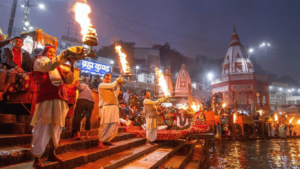
Beyond spiritual pursuits, Rishikesh offers adventure activities. The adrenaline rush of white water rafting, reaching up to grade 6, beckons thrill-seekers. Cliff jumping, kayaking, and body surfing provide additional exhilarating experiences. Picturesque waterfalls like Patna and Neer Garhi offer a retreat into the pristine wilderness. The mesmerizing Maha Aarti is a must-attend spectacle. Winter months (October-February) is the ideal time to explore this city.
5. Shimla- 341 Km
Serving as the capital city of Himachal Pradesh, Shimla stands as a testament to the natural wonders and adventure activities for which the state is renowned. Adorned with lush Pine, Oak, and Deodar forests, Shimla has magnificent architectural gems, a legacy of its past as the Summer Capital of British India. Remarkable structures like the Institute of Advance Learning, Gorton Castle, Bantony Castle, and Christ Church showcase brilliant neo-Gothic architecture. The Mall Road, a bustling shopping hub, invites evening strolls and cultural indulgences on the Ridge, offering splendid post-sunset views.

For wildlife enthusiasts, Shimla unfolds the Himalayan Bird Park, a delight showcasing exotic and native bird species. Nature lovers and photographers can find solace in the Shimla Reserve Forest Sanctuary. The city ensures a dynamic experience, with numerous engaging activities, whether it’s a leisurely walk on the Mall Road, shopping at Lakkar Bazar, savouring local cuisine, or exploring the city’s vibrant cultural scene.
Shimla attracts adventure enthusiasts keen on activities like camping, trekking, ice skating, paragliding, river rafting, and heli-skiing.The surrounding Himalayan ranges offer breathtaking trekking trails, from easy strolls through Pine and Oak forests to thrilling mountain adventures. The Best time to visit is between March- June.
6. Jaipur- 268 Km
Jaipur, the capital city of Rajasthan, was established by Sawaji Jai Singh in the 18th century. The vibrant streets of Jaipur weave a tapestry of new and old, showcasing a harmonious blend of chaos and color. Encircled by formidable walls and rugged hills, the city boasts well-preserved historical buildings and regal heritage. The City Palace, a symbolic landmark nestled in the city’s heart, continues to be the residence of the royal family. The Jantar Mantar, renowned for its extensive collection of ancient astronomical instruments, offers a fascinating journey through time. Prepare to be captivated by the architectural marvel of Hawa Mahal and be awestruck by the majestic Amber Fort.
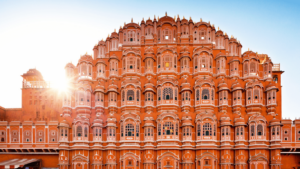
Beyond the city’s confines lie the Aravalli hills, providing ample trekking opportunities at Chouri Ghat and Bhuteshwar Nath. Cycling enthusiasts can explore the scenic surroundings through cycling tours, discovering seasonal waterfalls in the process. For getting a feel of the authentic Rajasthani culture, one can visit the Chokhi Dhani Village. Nahargarh and Jhalana open doors to wildlife photography and jungle safaris, while adventure seekers can indulge in ATV rides and zip-lining in Jaipur. Best time to visit is between October to March.
7. Haridwar- 212 Km
The ancient city of Haridwar in Uttarakhand holds significant importance as a major Hindu pilgrimage site that has drawn devotees for centuries. Situated at the sacred confluence of the River Ganga and the Himalayan foothills, Haridwar hosts the grand Kumbh Mela every 12 years. It is one of the seven holiest cities in India that is located on the banks of the holy Ganga River in the state of Uttarakhand. Panch Tirths (Five Pilgrimages) are one of the foremost places to visit in Haridwar – Har Ki Pauri, Mansa Devi Temple, Chandi Devi Temple, Kankhal, Kushavarta and many more.
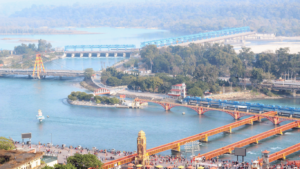
While religiosity remains a focal point in Haridwar, catering to pilgrims and devotees, the city has more to offer. Its culinary landscape is diverse and delightful, providing an excellent opportunity to savour authentic Indian flavour. Haridwar has become a destination for yoga enthusiasts, with numerous ashrams and centers dedicated to enhancing physical and mental well-being. Best time to visit is between March to November.
8. Mathura- 180 Km
Mathura stands as a sacred and spiritually significant destination in India, revered as the birthplace of Lord Krishna. This city holds profound religious and historical importance, making it a distinct and revered site. Mathura also welcomes international tourists keen on delving into the religious richness of Hinduism. Key attractions include the Govardhan Hill, Shri Krishna Janmasthan Temple, Dwarkadheesh Temple and the serene Vishram Ghat. These sites collectively contribute to the city’s cultural and spiritual tapestry, offering a meaningful experience for visitors seeking a connection with Hindu traditions and history. October to march is the ideal time to visit; try to get a glimpse of Holi for a unique experience !
9. Amritsar- 449 Km
Amritsar stands as the holiest city for Sikhs globally, its significance emanating not only in India but resonating across the world. The city derives its name from the sacred pool enveloping the renowned Golden Temple, translating to “the holy pool of nectar.” A visit to Amritsar remains incomplete without experiencing the serenity of the Golden Temple, also known as Harmandir Sahib, founded in 1604 by the 4th Sikh Guru. Jallianwala Bagh, a poignant shrine and the Akal Takht are other significant attractions. The Wagah Border ceremony, marking the India-Pakistan border, adds a patriotic fervour to your Amritsar visit.
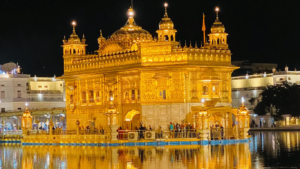
For nature enthusiasts, the Harike Wetland Sanctuary promises an exciting excursion, while the Amritsar Heritage Walk provides a fascinating journey through the city’s vibrant history. Amritsar’s culinary scene stands out, with local stalls offering delicacies rivaling esteemed restaurants. The best time to explore Amritsar is between November and March, avoiding the scorching summers and the wet monsoons.
10. Gwalior- 360 Km
Gwalior has been a seat of royalty for generations, and its regal structures contribute to the city’s allure. The city is adorned with architectural marvels, a testament to its royal heritage dating back to the time of King Surajesan, who founded this historic city. At the heart of the city stands the Gwalior Fort, often referred to as the ‘pearl among the fortresses’ in India. The fort’s complex houses numerous temples, water tanks, and palaces, creating a splendid destination for all. For those intrigued by palatial grandeur, Gwalior offers the Jai Vilas Palace, a breathtaking structure showcasing Gwalior’s art extravaganza. Serving as both a museum and the residence of the royal Maratha Scindia family, this palace exhibits intriguing items, including swords from the eras of Shah Jahan and Aurangzeb, along with a library. Another historical gem is the Man Mandir Palace, enthralling visitors with its ruins and captivating stories. This palace witnessed significant events, such as the imprisonment of Aurangzeb’s brother Murad and the site of the Jauhar Kund, where Rajput women committed mass suicide to evade Iltutmish’s forces. Noteworthy monuments within the complex include Jahangir Mahal, Shah Jahan Mahal, and the Gujari Mahal. For a glimpse into Indian architecture excellence, Padavali, an impressive fort, 40 kilometers from Gwalior, boasts ancient temples adorned with erotic carvings like Khajuraho.
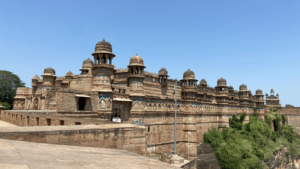
Visitors can also explore the Sun Temple, an architectural marvel or Teli Ka Mandir, the tallest building in Gwalior. Saas Bahu Temple, dedicated to Lord Vishnu, is another impressive religious site. Offbeat attractions like Tigra Dam, offering a serene boating escape, Gwalior Zoo and Shyam Vatika, featuring the world’s largest indoor mural, are noteworthy places not to be missed while exploring Gwalior. The Best time to explore the city is between September to March.
©Famous India Blog. All rights reserved.
Creativity By Needinfotech